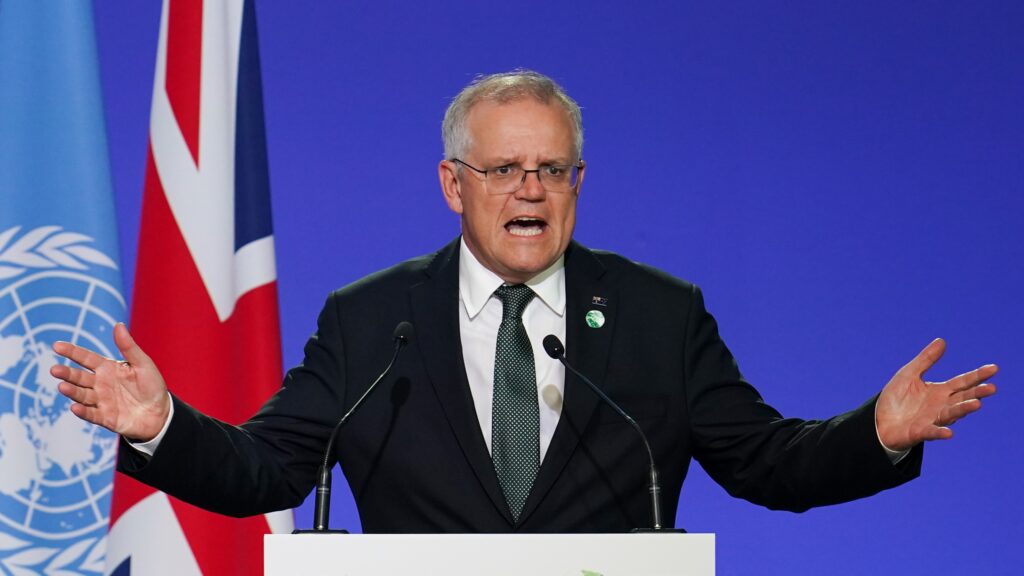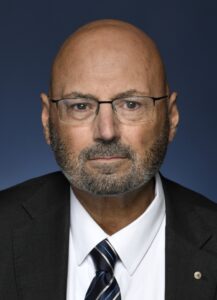
Scott Morrison, Prime Minister of Australia speaks at the COP 26 United Nations Climate Change Conference. (Photo by Ian Forsyth/Getty Images)
WASHINGTON: Australia’s Prime Minister today unveiled a major commitment to develop some 60 critical technologies, hours after the country’s ambassador to the US told reporters here that America’s antipodean ally is also focusing on the high-tech, non-submarine parts of the AUKUS partnership.
Speaking to the Defense Writers Group on the 70th anniversary of the ANZUS Treaty and the 10th anniversary of Australia agreeing to host US Marines and engage in Air Force cooperation, Ambassador Arthur Sinodinos said those other considerations, “whether it’s an artificial intelligence and machine learning, cyber, other undersea warfare capabilities and quantum, are all very important capabilities for Australia to develop high-level capacities in, and we cannot do this on our own.”
RELATED: What AUKUS means to Australia: More than nuclear subs
Among those efforts, Australia has stood up “a guided weapons explosive ordnance enterprise, which will build up a sovereign capability in precision-guided munitions. We’re looking at our long-range missile options. So we’re doing a whole series of things. We’re not just putting all our eggs in the submarine basket,” Sinodinos said.
Prime Minister Scott Morrison offered a slightly broader version of those remarks today.
“AUKUS will see Australia, the United Kingdom and the United States promote deeper information sharing; foster greater integration of security and defense-related science, technology, industrial bases and supply chains; and strengthen our cooperation in advanced and critical technologies and capabilities,” Morrison said in remarks at the first Sydney Dialogue put on by the Australian Strategic Policy Institute.
In a parallel effort, Morrison announced a Blueprint for Critical Technologies, laying out 63 entries on the “Critical Technologies List” with nine at the very top. While there is overlap between the list and the AUKUS technologies being pursued, Ambassador Sinodinos, made clear that the blueprint is a broader, more commercially focused effort. Of those 63 techs, one — quantum — got all the attention.
“Quantum science and technology has the potential to revolutionize a whole range of industries, including finance, communications, energy, health, agriculture, manufacturing, transport, and mining,” Morrison said. “Quantum sensors, for example, could improve the discovery of valuable ore deposits and make groundwater monitoring more efficient; and quantum communications could provide for secure exchange of information to better secure financial transactions.
“Quantum technologies will also have defense applications, like enabling navigation in GPS denied environments and helping to protect us from advanced cyber attacks,” he said.
Australia’s Chief Scientist, Cathy Foley, will lead development of the country’s first National Quantum Strategy. And the government is investing $70 million (AUD), about $51 million USD, in something he called the Quantum Commercialisation Hub. Part of creating the hub is a joint cooperation agreement Australia has signed with the United States, he said.
In other news, the Australian ambassador confirmed unequivocally that the “mature” submarines his country will buy will use highly enriched uranium. Former Australian Prime Minister Malcolm Turnbull told Breaking Defense his country should not use HEU, but using Low Enriched Uranium (LEU) would require designing and building a new nuclear power plant for the Australian subs. And Australia wants to get these boats in the water as soon as possible.

Arthur Sinodinos, Australian Ambassador to US (Australian Department of Foreign Affairs and Trade)
“The subs would be using HEU, and we’re just working out now the arrangements what that will mean in practice. But the whole point is for us to avoid the need to have a civilian nuclear industry because, apart from anything else, we thought if we went down that route, it might conflate in the public’s mind what we were doing and raise broader issues about the politics of nuclear power,” the ambassador said.
Which model sub will be built and where, as well as the myriad of details the three countries need to hammer out about the mammoth enterprise for a country of 25 million souls, will be clarified and decided over the next 12 to 18 months, Sinodinos said. In related news, the Wall Street Journal reported Tuesday that former defense policy undersecretary Jim Miller will lead the US side in all things AUKUS. That should help move things along.
On the subject of truly integrating Australia into America’s National Technology and Industrial Base, which has occurred in law but not in practice, the ambassador made clear his country will press the US for results.
“We’re actually looking at ways we use those processes to actually get more traction on our participation in the National Technology and Industrial Base, because the whole basis of the capabilities we’re talking about here is it’s about interoperability. It’s about joint capabilities. So, whether it’s in the context of work that’s now going on about the National Defense Authorization Act, or whatever, we will be making strong representations about recognizing the role of allies and partners,” he said.
Sinodinos, pointing to the Biden administration’s statements about supply chain issues and the value of working with partners, said, “So I think that gives us a chance to have a dialogue about what does Made in America mean in practice, when we’re thinking about having a force multiplier by working together.”
RELATED: Why ‘Buy American’ isn’t the answer to safeguard national security supply chains






















